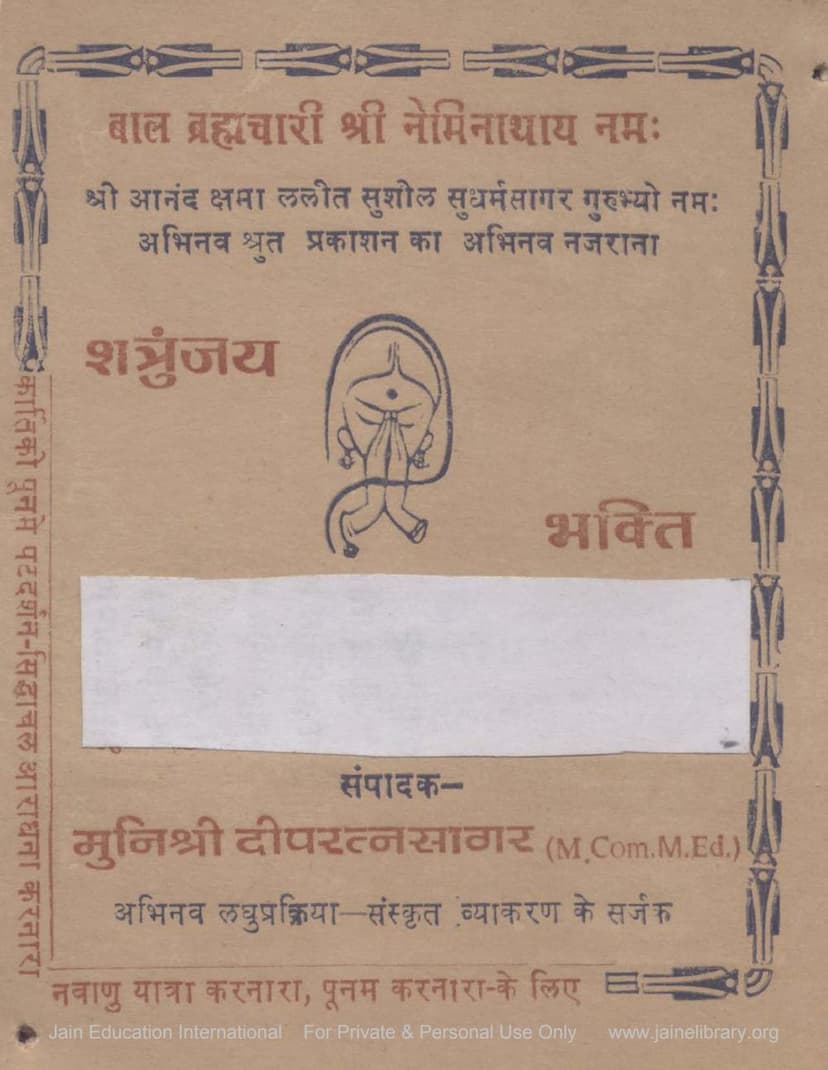Shatrunjay Bhakti
Added to library: September 2, 2025

Summary
Here's a comprehensive summary of the Jain text "Shatrunjay Bhakti" by Dipratnasagar and Deepratnasagar, based on the provided pages:
Title: Shatrunjay Bhakti (Devotion to Shatrunjay) Author(s): Munishri Dipratnasagar (M.Com., M.Ed.) Publisher: Abhinav Shrut Prakashan Catalog Link: https://jainqq.org/explore/003631/1
Overall Purpose: "Shatrunjay Bhakti" is a devotional text primarily designed for Jain pilgrims undertaking the journey to the sacred Shatrunjay (Siddhachal) mountain, a paramount pilgrimage site in Jainism. It also serves those who wish to perform a virtual pilgrimage or devotion from afar, particularly on auspicious occasions like Kartik Purnima. The book provides a collection of prayers, salutations, hymns, and devotional songs (stavan) to be recited at various significant locations on and around Shatrunjay.
Key Content and Structure:
The book is structured as a guide for performing devotion at different stages and locations of the Shatrunjay pilgrimage. The "Anukramanika" (Table of Contents) outlines the following sections:
- Taleti (Base of the Mountain): Devotional verses for the foot of the mountain.
- Shri Shantinath: Prayers and devotion dedicated to the 16th Jain Tirthankara, Lord Shantinath.
- Shri Adinath: Prayers and devotion dedicated to the first Jain Tirthankara, Lord Adinath (also known as Rishabhdev).
- Rayan Pagla (Footprints under the Rayan Tree): Devotional verses related to the sacred footprints of Lord Adinath found under the Rayan tree.
- Shri Pundrikswami: Devotion to Pundrikswami, the chief disciple of Lord Adinath.
- Gheti Pagla (Footprints on the Path): Devotional verses for other significant footprints encountered on the pilgrimage route.
- 21 Khamasamana (21 Prostrations): A set of 21 specific devotional verses.
- Taleti thi Gheti Pali Ka (From Taleti to Gheti): A section that may cover the journey between these points.
- Other Stavan (Hymns): Additional devotional songs.
- 108 Khamasamana (108 Prostrations): A more extensive set of devotional verses.
Key Themes and Practices:
- Pilgrimage Rituals: The book emphasizes the importance of performing specific rituals at various points. This includes:
- Chaitanya Vandana (Salutation to the Sacred Places/Idols): Reciting specific verses while visualizing or physically visiting sacred sites.
- Stuti (Praise/Invocation): Singing hymns of praise to Tirthankaras and sacred beings.
- Thoy (A Form of Devotional Song/Praise): Specific devotional compositions.
- Khamasamana (Prostrations): Performing acts of penitence and reverence through bowing.
- Pradakshina (Circumambulation): The text includes "Trun Pradakshina na Doha" (Verses of Three Circumambulations), which explain the spiritual significance of circumambulating the sacred mountain, linking it to acquiring Right Faith (Samyakdarshan), Right Knowledge (Samyakgnan), and Right Conduct (Charitra).
- Devotion to Tirthankaras: The core of the book is devotion to the Jain Tirthankaras, particularly Lord Adinath and Lord Shantinath, who are prominently featured. The verses highlight their virtues, divine qualities, and their role in liberation.
- Significance of Shatrunjay: The text consistently emphasizes the immense spiritual significance of Shatrunjay, often referring to it as "Vimalgiri" or "Siddhachal." It is described as a place where countless souls have attained liberation (moksha) and where every stone is sanctified by the presence of Siddhas (liberated souls). The mountain is portrayed as a source of spiritual merit, sin eradication, and ultimate happiness.
- Virtual Pilgrimage (Bhav Yatra): The preface highlights that the book is useful for those who cannot physically visit Shatrunjay but can perform a "Bhav Yatra" (mental or emotional pilgrimage) before the "Shatrunjay Pat" (representation of Shatrunjay).
- Spiritual Aspiration: The devotional verses express deep longing for liberation, detachment from worldly desires, and the attainment of spiritual knowledge and conduct.
- Author's Contribution: The editor, Munishri Dipratnasagar, is recognized for his expertise in Sanskrit grammar, as the creator of "Abhinav Laghuprkriya." The preface notes the book's popularity, with 8,000 copies sold in Hindi and Gujarati within two years, indicating its success in fulfilling a spiritual need.
Notable Mentions and Details:
- Kartik Purnima: This full moon day is highlighted as a particularly auspicious time for devotion to Shatrunjay.
- Lord Adinath's Footprints: The "Rayan Pagla" and "Gheti Pagla" sections are dedicated to specific footprints, underscoring their veneration as relics of the Tirthankaras.
- Pundrikswami: His role as the chief disciple and his connection to Shatrunjay are emphasized, with verses describing his spiritual attainment on the mountain.
- "21 Khamasamana" and "108 Khamasamana": These sections suggest structured practices for penance and devotional recitation.
- "Khamasamana": This is a fundamental Jain practice of bowing and seeking forgiveness, and the book integrates it into the pilgrimage rituals.
- "Kausagga," "Logassa," "Navkar," "Jinkichi-Namutthunnu," "Javant-Namo'rhat": These are standard Jain prayers and recitations that are incorporated into the devotional sequences.
In essence, "Shatrunjay Bhakti" is a comprehensive devotional guide that aims to facilitate a deep spiritual connection with the holy site of Shatrunjay and its revered Tirthankaras, enabling both physical pilgrims and those performing virtual worship to experience the sanctity and benefits of this sacred pilgrimage.